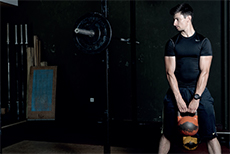




| Home | Features | Club Nights | Underwater Pics | Feedback | Non-Celebrity Diver | Events | 25 April 2024 |
| Blog | Archive | Medical FAQs | Competitions | Travel Offers | The Crew | Contact Us | MDC | LDC |

|

|
 
 |
    ISSUE 22 ARCHIVE - HSE DIVE MEDICALS - OUR DOCS HELP YOU GET FITDr Michael Gonevski and Dr Oli FirthIt should be no secret by now that the rules concerning HSE dive medicals have recently been revised, these new guidelines are somewhat stricter to what divers have experienced in the past, so much so that divers seeking a medical are now having to make sure that they are at their peak physical fitness to ensure that they get their certificate. According to HSE guidance, candidate divers with a Body Mass Index (BMI) of greater than 35 will be found unfit to dive, so it really is time to get serious about your waistline.The consequences of these changes have meant a considerably lower pass rate, not good if you are an instructor or diving is your "bread and butter" income. Some may argue that the new rules are killing sport diving, however we think that a fit and healthy UK dive force can only be a good thing, so to make sure you get the thumbs up, take some handy diet and exercise tips from the guys who know best... HIIT it HardDr Michael Gonevski "Hi Doc, thank you for taking me through my HSE medical this morning. Having failed on what I think was a waist of 106 cm and Vo2 Max of 30, as outlined by the new HSE guidelines, I am struggling to find a training program that will be helpful for me to use at home, something that is more convenient for me due to work commitments. Please, can you advise on this?" I keep getting e-mails similar to this ever since the new HSE guidelines came into effect on 1 October of last year and the failure rate of the HSE diver candidates increased exponentially as a result. The ballbreaker in particular seems to be the set standard of VO2 max of >= 45 mlsO2/kg/min and a BMI < 30. So when it comes to concepts, you need high concept, low tech. Slow, steady activity like jogging, treadmill, rowing or walking the dog is not going to cut it. High Intensity Interval Training (HIIT) is the way to go. And it is simple, just exercise for 15-20 minutes at regular intervals for maximum intensity and you'll sky rocket your metabolism for the following 24 hours. It is no secret that I like the kettlebell as a tool of choice. No, scratch that, I love the kettlebell. But the following exercises can be performed with a dumbbell too, if this is the only thing that you have. So here are a few suggestions:Do 10 kettlebell swings, every minute, on the minute for 20 minutes. 10 swings may take you 20 seconds to complete. For the remainder of the minute just shake off the tension and relax – just remember that you should not stand still or bent over and keep moving. When the next minute starts, hit it again. That simple.16 kg Kettlebell for men, 12 kg Kettlebell for women. Of course, be sensible and slowly build up to it. Two, eventually three times a week is what you have to aim for. The key factor is that in order to maintain high intensity each repetition of the Kettlebell Swing has to be identical to the very first one you did. Body English is not allowed. In this way you can actually maintain the intensity high unlike running or rowing, where as you get more tired your intensity level will inevitably drop despite your best intentions. You can do other training too. The real trick however is not how much work you can do in one session but how much work you can recover from and still keep pushing on. The same concept can be applied to a purely body weight exercise, like the burpee. 10 burpees every minute, on the minute, for 20 minutes. You get the idea. Another one of my favourites is combining two whole body exercises. So how does it work?Let's take for example the Kettlebell Swing and the good old fashioned Push Up and combine both in a pyramid workout. You start with one repetition each, 1 KB swing, followed immediately by 1 Push Up, then 2 KB Swings, 2 Push ups all the way up to 10, then you reverse all the way to one. You can do this pyramid set as a finisher at the end of your normal workout. That is 100 swings and 100 push ups, 200 in total. And here is another one. You do 15 repetitions of the Kettlebell Swing (dumbbell can be used as a substitute) followed immediately by 15 repetitions of burpees. Without resting, do 14 reps of the swing and then 14 reps of the burpee. Continue this pattern until you complete one rep of each exercise. If you do the maths, that is 120 reps each, 240 in total. And these movements challenge the whole body. They are done at a fast pace, on average it will only take you three seconds per rep. So you'll finish in just 10-12 minute or so. That will light your muscles on fire and have you grasping for air (in a good way). If you think that sounds too easy, I suggest you try it. You may find you can't even finish. Of course, there are ways around it, you can start with a lower number, like 8 or 10 and work your way up. Or if you want a greater challenge you can repeat the whole routine or use a heavier kettlebell. What's more, these workouts force more of your muscles into action than you'd ever use while jogging for the same duration. It'll also boost your metabolism for hours after your workout. Unlike jogging, these aren't joint pounding exercises. So this is actually a low impact workout that you can do at high intensity, making it ideal for overweight folks. The best part is that you can do this routine without even leaving the comfort of your own house, since all you need is a single kettlebell or dumbbell. You have to eat clean as well. You have to eat clean as well. Did I just repeat myself? But admit it, you already knew that. Doing a workout and then going down the boozer and smash it up with pizzas is definitely going to take you nowhere. Plan well in advance and give yourself at least three months with this type of training and the next time you show up for an HSE medical you'll breeze through it. You can thank me later. And remember folks, we don't drink flowers and chocolate. The mechanics of the Kettlebell SwingSince we are going to focus on one central movement – the Two-Hand Kettlebell Swing- you might want to learn to do it correctly. It is not complicated or very advanced but creating a connection to all parts of your body that come to life in the swing will bring in the rewards. So let's start from the beginning. Place a kettlebell about six inches in front of you on the ground. Here is the complete swing, broken down in into steps. Hike back and up. Stand up swing, bringing your extended arms to about hip height. Hinge back and down at the hips while reaching and pushing the bel behind you. Stand up and swing. End by bending your knees, letting the bell swing behind you and then land out in front as you softly place it back on the ground. I want to make one important distinction –the Swing is not a Squat or a Front Raise. You move the bell with the power of your hips, not by raising it with your arms. When people first see the swing and try to recreate it, they often go into a squat – for some reason it is the way their brain communicates the movement to their bodies. The problem is, if you are just doing a squat with the kettlebell, you are missing the most powerful and important part. A squat is an up and down movement; a hinge allows you to swing back and forth. When you squat, your knees bend and move forwards you move up and down while staying vertical. Hinging on the other hand originates from the point where your legs meet your torso. When you hinge, you lean forward and put your butt backward while keeping your shins vertical. This creates a back-and-forth motion, instead of an up-and-down one. You also want to pay attention to your arms and shoulders. Don't try to lift the bell in front of you with your arms, instead let your hips drive the momentum and create the momentum. Your hips are much stronger so let them lead. During the Kettlebell Swing inhale through the nose as you swing it behind you and exhale through the mouth on the upswing. Exhaling at the top of the swing should be with bracing of the abs at the top of the swing, like someone is trying to punch you in the stomach. As you are bracing your abs you should be letting out a short, sharp exhale. Inhale through the nose on the next rep and repeat. Don't worry; this will become perfectly natural in a very short period of time. Diet SuggestionsDr Oli Firth Nothing causes more acrimonious argument than the composition of the perfect bacon butty. Food science researchers at Leeds University even created a formula to settle things once and for all, testing 700 variations before proclaiming the secret: 2-3 back bacon rashers, grilled for 7 minutes at 240 degrees C, sandwiched between 2 slices of farmhouse bread (each 1-2cm thick). I would have to add butter and brown sauce. Cue cries of heresy and imminent death threats... One thing is certain, however: bacon butties, beers and between-dive sweet treats do not a fit diver make (a lesson from the University of the Bleeding Obvious). If you want to put your body into the high pressure, alien environment of the deep, probably best to feed it some fuel it can work with effectively. Ideally this needs to be done a few days before diving. Carbohydrate loading should be of the healthy variety (rice, pasta, veggies) and get some protein in there too (lean meat, fish, low fat dairy stuff). Steering clear of fatty foods will help avoid that heavy-stomached lethargy on dive day. And on that auspicious day, try to keep portion sizes small to avoid getting too burpy and belchy. After a dive, chow down some carbs as soon as possible to replenish your muscle stores (bananas or sports bars are good). Hydration is key – the golden rule is to keep your wee copious and clear (pee valves at the ready). Much like equalising, the best way to hydrate is "little and often". Sipping on bottles constantly will spread the intake of the 2-3 litres of liquid you need over the course of a day. Diluted juice is better absorbed than plain water, and if the squits are in full effect then rehydration solutions are better still. If there are none available, you can make your own up: 8 teaspoons of sugar and 1 teaspoon of salt in a litre of drinking water is a safe alternative (add a squeeze of an orange or lemon to make it more palatable). Previous article « Why Sports Stars Need HBOT Next article » The Good Fish Guide Back to Issue 22 Index |